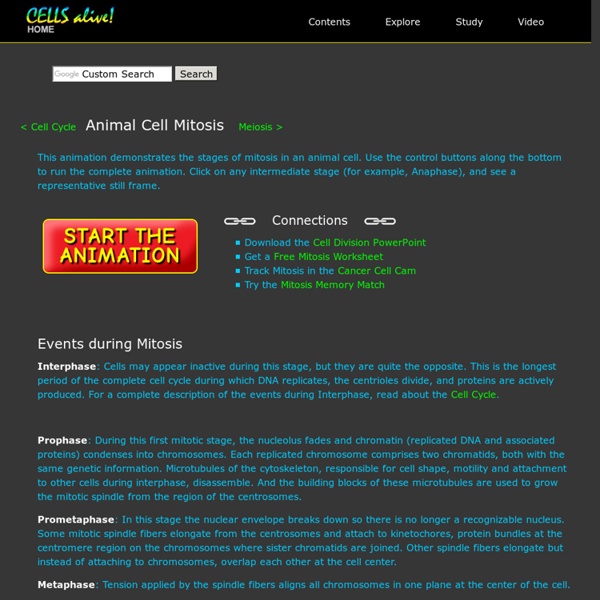Mitosis: An Interactive Animation
This animation demonstrates the stages of mitosis in an animal cell. Use the control buttons along the bottom to run the complete animation. Click on any intermediate stage (for example, Anaphase), and see a representative still frame. Interphase: Cells may appear inactive during this stage, but they are quite the opposite. Prophase: During this first mitotic stage, the nucleolus fades and chromatin (replicated DNA and associated proteins) condenses into chromosomes. Prometaphase: In this stage the nuclear envelope breaks down so there is no longer a recognizable nucleus. Metaphase: Tension applied by the spindle fibers aligns all chromosomes in one plane at the center of the cell. Anaphase: Spindle fibers shorten, the kinetochores separate, and the chromatids (daughter chromosomes) are pulled apart and begin moving to the cell poles. Telophase: The daughter chromosomes arrive at the poles and the spindle fibers that have pulled them apart disappear.
EXPERIMENT 7: Are chemicals, mutations, and cancer linked
The Virtual Ames Test: Are chemicals, mutations, and cancer linked? A lesson in mutation and selection Life is a collection of chemicals. Thousands of different molecules are required for the cellular functions of every plant, animal, and microorganism. Many human diseases, including certain types of cancer, have been associated with long-term exposure to certain synthetic chemicals (made by people) that are used in industry and agriculture. In contrast with the popular view and the position taken by the federal regulatory agencies, some people believe we should focus on the activity of a chemical and how much of it we are exposed to, not whether it was synthesized in a factory or made by a plant, animal, or microbe. One of the areas in which this debate about chemical safety has become quite heated is in the regulation of chemicals based on their potential for causing cancer. The Ames test is based on the following theories and assumptions: Key Concept Your Challenge Key questions
Related:
Related:



